E-Archive
Articles
in Vol. 11 - March Issue - Year 2010
Application Range From Blast Cleaning And High Pressure Water Jet Cleaning Up To Sophisticated Shot Peening
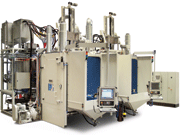
The wet blast system is designed for shot peening of 14 different types of turbine blades with a maximum length of 1,150 mm. Equipped with two stainless steel blast cabins, the system guarantees a high parts throughput.
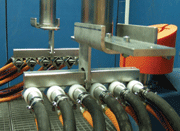
The work piece fixtures holding the turbine blades are placed on rotating satellite stations. The 12 blast guns are moved by a multi axis CNC gantry system with an accuracy of 0.1 mm. The slurry consisting of media and water is accelerated in the blast gun by compressed air.
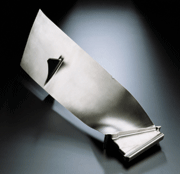
Turbine components like, for example, turbine blades undergo a shot peening process to induce a compressive residual stress in the upper surface layers of the parts. This applies to newly manufactured turbine blades as well as blades that need to be refurbished.
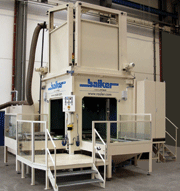
This shot peening system with two load/unload stations is equipped with two independent blast systems and 2 x 4-axis gantries guiding the blast guns. This allows the simultaneous peening of the inside and outside surface of the parts.
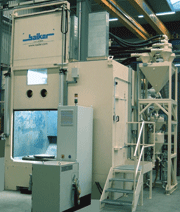
This 20 year old pressure blast system was refurbished to comply with up-to-date technical standards by replacing the controls, the robot and the blast system and by installing a new door.
Due to stringent safety requirements, consistency and repeatability is essential in both the manufacturing of new aircraft engines as well as the associated MRO operations tied to airplane engines and structural components; while at the same time, increased cost pressures require a high degree of cost efficiency. Both requirements can only be fulfilled with innovative production and maintenance systems. Surface preparation and finishing processes are essential to make these production and MRO operations reliable and economical.
Weight reduction of key components which results in reduced fuel consumption and a reduction of noise emissions are the most significant areas of research and innovation in the aerospace industry. These goals are achieved by utilizing new materials and applying new technologies which, for example, will improve the thermo-dynamic properties of aero engines. When it comes to safety, cost efficiency and eco-friendliness, blast stripping and blast cleaning processes play a key role in manufacturing as well as the MRO operations. Rösler offers custom engineered shot blast systems – from relatively simple dry or wet blast cleaning systems up to high tech high pressure water jet blasting and shot peening systems. These Rösler systems distinguish themselves by providing a high degree of automation, absolutely repeatable results due to constant monitoring and adjustment of all relevant blast parameters and excellent equipment quality. Rösler systems are in use at many leading aerospace equipment manufacturers and maintenance operations throughout the world. By taking advantage of the innovative know-how we acquired during our takeover of Baiker and Vapor Blast, Rösler has become a technological leader in the field of aerospace surface finishing and surface preparation.
Dual Cabin Wet Blast System for Turbine Blades
Aircraft engine components are exposed to extreme mechanical and thermal loads, which is why they are made from highly heat resistant steel and titanium or nickel-based alloys. Shot peening is used for newly manufactured turbine parts as well as for refurbishment of existing parts as it induces residual compressive stresses into the outer surface layers of the parts and, thus, increases their tensile and bending strength resulting in higher resistance to wear and fatigue corrosion.
Recently, Rösler delivered a custom-engineered wet blast peening system for turbine blade refurbishment to a leading aerospace company. The wet peening system is equipped with two highly wear resistant stainless steel cabins which ensures high parts throughput.
The peening system itself is designed for processing up to 14 different turbine blades, mainly fan blades, with a maximum length of 1,150 mm. To start the programme the operator registers the blade to be peened with a barcode reader. Subsequently, the graphic display built into the control panel shows a picture of the turbine blade and the parts-specific work piece fixture. The fixture, which completely masks/protects the root of the turbine blade - is mounted onto a rotating satellite station. A computer numerical control (CNC) multi-axis gantry system working with a positional accuracy of 0.1 mm controls the movement of the 12 blast guns. The combination of satellite rotation and blast gun movement ensures that the blast media, accelerated by compressed air and consisting of a mix of ceramic beads and water, always hits the parts surface of the curved turbine blades at an optimum angle.
A sophisticated rinse system reaching the complete interior of the cabin flushes the thrown blast media from the cabin and transfers it to the media cleaning and classification system. Broken down media that is no longer usable is discharged with a hydro cyclone, and undersize media left in the water/slurry mix is carried out with a moving bed paper filter. The cleaned, re-usable media is transported back into the slurry tank with an auger.
Water loss due to evaporation and carryout is made up with a special replenishment system. A specially designed wear resistant pump pumps the mix of media and water to the blast guns from where it becomes accelerated with the introduction of compressed air. This process ensures that the ratio between water and media remains constant at the pre-set value.
The customer specifications called for an Almen value of 0.370 – 0.450 mm on an "N" strip within a cycle time of 10 minutes, and 15 sequential Almen readings can only show a deviation of 0.02 mm from the specified values. To maintain such tight tolerances all blast parameters concerning process stability and repeatability such as media concentration in the slurry and air pressure are constantly monitored and documented.
Efficient "stripping" of Coatings from Landing Gear Components
The same aerospace company also invested in a blast cleaning system from Rösler for under-carriage parts that have a height of up to 3.5 m and a weight p to one metric ton. The blast machine is equipped with a very high double wing door which also partially opens the roof of the blast cabin. This allows transporting of raw, non-blasted parts into the cabin by crane where they are placed onto a rotary table whose rotation acts as additional axis for the robot. After the operator has selected the parts specific processing program the turntable rotates to a position from where the part is facing the robot; then the cabin doors close sealing the blast area from the surrounding area. The system is equipped with a tool changer allowing the robot to automatically pick up the blast gun specified for the next blast operation. The tool changer also contains a lance with a rotating blast nozzle that is utilized for the removal of coatings in bores and other cavities on the part. While the robot is blast cleaning the outside of the part with aluminum oxide, a lance moving up from the turntable, is simultaneously stripping the inside of the part. This double function helps minimize cycle times and keeps the coating removal process highly efficient.
Per customer request the blast cabin was equipped with a manual touch-up system allowing the operator to enter the blast cabin in protective clothing to manually blast certain part sections; therefore, safety switches are in place to disable the robot, when the operator enters the blast cabin.
This particular Rösler blast installation also includes an external blast cabinet for manual blasting of small parts, and the work in the blast cabinet can take place simultaneously with the operation of the robot. All important blast parameters are automatically monitored, adjusted and documented.
Highly Flexible Shot Peening of Turbine Parts
Another leading manufacturer of aircraft turbines recently purchased a shot peening installation from Rösler for the peening of turbine components up to 1,200 mm in width and 1,000 mm in height. The blast system is equipped with two load stations which allow the shot peening of one part in the blast chamber, while the swing table is being loaded/unloaded with another part.
However, there are additional double features integrated into this system: It is equipped with two blast systems and two 4-axis gantries that are mounted to the ceiling of the cabin and the rear wall. Each blast system is equipped with three guns. This arrangement allows the targeted blasting of different sections on the parts. Two double pressure vessels guarantee a consistent and continuous shot peening process. This dual concept allows simultaneous blasting of the outer and inner parts surfaces with different blast intensities, and it also allows the use of two different sizes of media which can be quickly exchanged. This flexibility guarantees a highly effective operation, even though the cycle times may last for several hours.
To ensure a high degree of process safety and repeatability, all process parameters such as media flow rate, pressure in the blast system and air volume are constantly monitored, adjusted and documented. The varying data tracking and adjustment systems are highly precise so that the tolerance of the media flow rate is less than 5%, and the pressure tolerance is not larger than 0.05 bar.
This particular peening installation is partially enclosed with a sound enclosing cabin so that the emitted noise level does not exceed 75 dB(A)
Stripping of Thermal Coatings with Pure Water
Refurbishment of aircraft turbines requires, among other operations, the removal of thermal coatings such as very hard plasma coatings from various components. One of the largest maintenance and refurbishment organisations in the world is utilising a high pressure water jet system from Rösler for its stripping operations. The Rösler system is equipped with a stainless steel blast cabin and a turntable that can be moved in a linear direction which allows the treatment of turbine components with different widths and diameters.
The high performance plunger pump, with a 132 kW motor, generates a high pressure 4,000 bar water jet which is dispensed with a multi-rotational nozzle that is guided by a 6-axis robot. For safety reasons all of the piping is specified for a pressure of 6,000 bar. The water delivery of 11.7 liters/minute combined with the nozzle rotation generates a "grinding" effect which causes a fast and precise, but, at the same time; very gentle stripping of the coating without any deformation of the parts surface and without any residual surface contamination. Depending on the type and thickness of the coating, stripping speeds from 4 up to 75 mm²/sec are possible.
The high pressure water jet system is also equipped with a waste water treatment plant that allows the recycling of the process water for multiple uses. In a first step the process water contaminated with particles from the coating material is passing through a bag filter whose specifications depend on the type of coating material being stripped. There must be a bag filter for every type of coating in order to prevent a potential chemical reaction that could be caused by mixing the particles of different coating materials. The pre-cleaned process water then passes through a centrifugal filter with a centrifugal force of 2,010 g that removes about 99% of all solid fines from the water. Finally, in a downstream cartridge filter all fines with a particle size of >/= 1.0 µ are removed. Our unique water treatment process guarantees a long life of the high pressure pump. Any bacteria that might contaminate the process water are removed with a special ozone unit.
Modernization of Existing Blast Systems
Rösler is also partnering with the aerospace industry, when it comes to modernization of existing blast systems and bringing them up to prevailing standards. This was the case with a 20 year old pressure blast system that is used for stripping and surface preparation of rotational parts. The move to a new building required the modification of a door. So the customer used this opportunity to also update the blast system, the robot, and to install a new, state-of-the-art control panel. The new robot is fully integrated into the blast cabin and is equipped with a highly wear resistant protective rubber sleeve. Compared to the pleated boot previously used, the robot has now a considerably larger radius of movement.
For Information:
Rösler Oberflächentechnik GmbH
96190 Untermerzbach, Germany
Tel. +49.9533.924-0
Fax +49.9533.924-300
E-mail: info@rosler.com
www.rosler.com



























